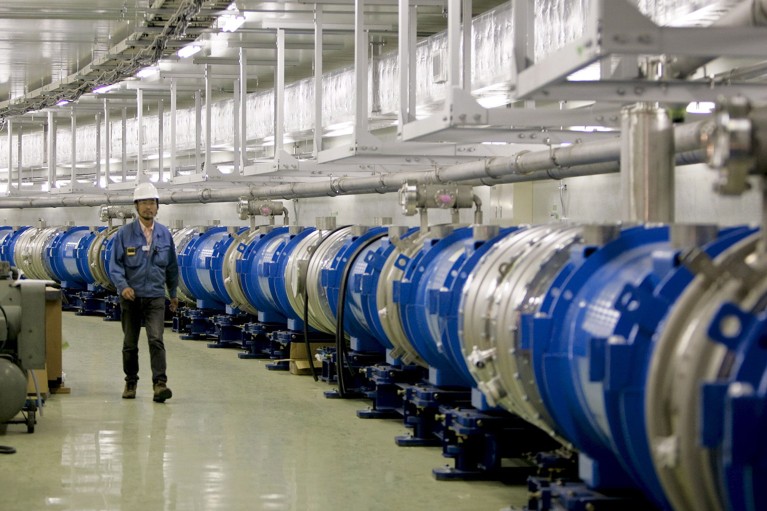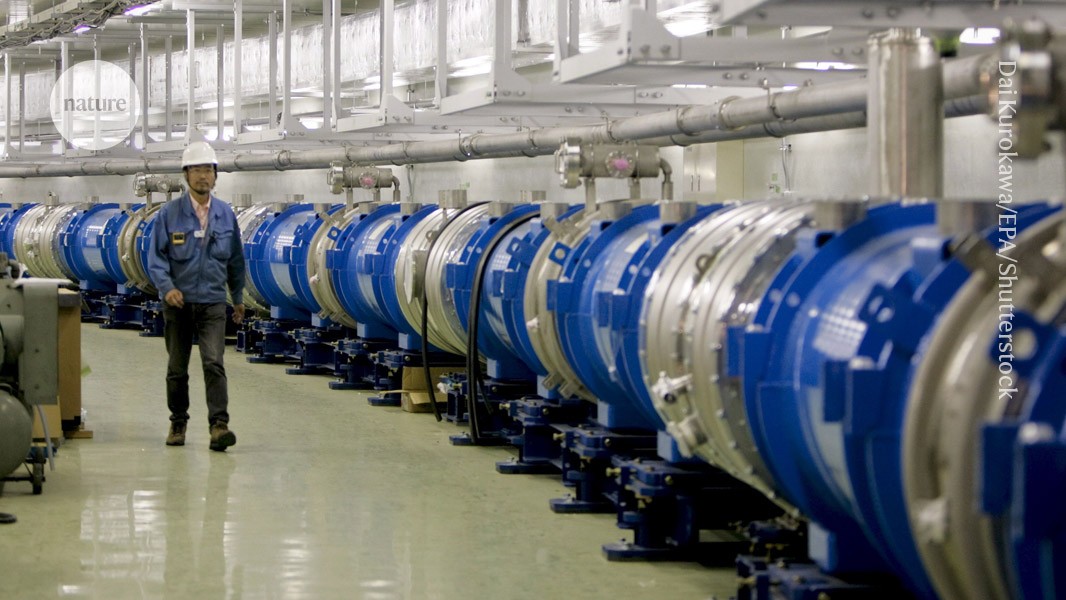
A worker at the Neutrino Experimental Facility at the Japan Proton Accelerator Research Complex (J-PARC) in Tokai.Credit: Dai Kurokawa/EPA/Shutterstock
For the first time, researchers have accelerated muons — the heavier, unstable cousins of electrons — into a tightly controlled beam, bringing the vision of a muon collider a step closer to reality.
A team at the Japan Proton Accelerator Research Complex (J-PARC) in Tokai shot a laser at a stream of muons to bring the fast-moving particles to a near-standstill. Then, the researchers applied an electric field to accelerate these ‘cooled’ muons to around 4% of the speed of light. The findings, which are yet to be peer-reviewed, were posted on 15 October on the arXiv preprint server1.
The feat is a “great step forward” in the approach needed to build a muon collider, which could be used to make the exquisitely sensitive measurements required to uncover new physics but be smaller and potentially cheaper to build than other particle colliders, says Tova Holmes, a particle physicist at the University of Tennessee, Knoxville.
Muons are short-lived fundamental particles that are almost identical electrons, but with more than 200 times the mass. Over the past decade, there has been growing momentum towards building a compact muon collider that could match or exceed the energies achieved by sprawling proton and electron colliders, such as the 27-kilometre Large Hadron Collider at CERN, Europe’s particle-physics laboratory near Geneva, Switzerland. A 10-kilometre muon collider could produce particles that have as much energy as those from a 90-kilometre proton machine, because muons are fundamental particles, which means all of their energy goes into each collision. On the other hand, proton collisions occur between their constituent quarks.
Tricky particles
But muons are fiendishly difficult to accelerate because they only exist for around 2 microseconds before they decay into an electron and two types of neutrino. They also dart around in different directions at various speeds, making them difficult to tame into a narrow, high-intensity beam. Although researchers have accelerated muons before, the beams “are highly divergent”, says study co-author Shusei Kamioka, a particle physicist at the High Energy Accelerator Research Organization in Tsukuba, Japan. As a result, the beams are too unruly to be used for sensitive measurements.
To overcome this roadblock, Kamioka and his colleagues shot a beam of positively-charged muons, the antimatter counterpart of muons called antimuons, into silica aerogel — a sponge-like material that’s often used as a thermal insulator. When the positive muons hit electrons in the aerogel, neutral atoms of ‘muonium’ formed. The researchers fired a laser at these atoms to strip away their electrons, turning them back into positive muons that were almost frozen in place. This cooling process made the particles’ speeds and directions uniform.
Next, the researchers used an electric field to accelerate these slowed-down muons to an energy of 100 kiloelectronvolts, achieving a speed of around 4% that of light.
Although the results are promising, there’s still a long way to go before muon colliders will become a reality, says Holmes. The approach would need to be scaled up to produce even tighter, higher-intensity beams, she says.
Kamioka said he and his colleagues are developing the technology needed to accelerate muons to 94% of the speed of light, and hope to achieve this by 2028. “That is our next milestone,” he says.
Besides building a future collider, physicists could use high-energy muon beams in experiments that could go beyond the standard model of particle physics, such as precisely measuring the muon’s mysterious magnetism — which has shown to be stronger than predicted by theory, says Kamioka.


